|
|
|
Bindery Services
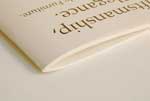 |
Saddle Stitching
In saddle stitching, the way most booklets, magazines, catalogs, calendars, and many other printed documents are bound, wire staples hold the piece together. A machine drives them through its backbone fold to the centerfold, where they clench. A saddle-stitched printed piece lies almost flat when opened, a convenience for readers.
However, saddle stitching involves certain mechanical requirements. A saddle-stitched document must be at least eight pages long and increase in length in four-page increments. Saddle stitching is a good choice for binding documents of up to 64-80 pages on 60# to 70# paper. Documents involving more pages, or thicker than 3/8", demand some other type of binding.
|
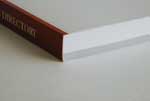 |
Perfect Binding
To produce a perfect-bound (also known as “adhesive”) document, the piece’s folded signatures are gathered together in page sequence, clamped together, and placed in a machine that slices about1/8" off their left edges. Then roughers mill the newly sliced sheet edges to prepare them for gluing. Finally, the edges receive an adhesive application and adhere to a backing.
Perfect binding is well suited for use with books and thick magazines, annual reports, technical manuals, and catalogs. From a minimum thickness of 1/8", it works well with a wide range of document thicknesses and trim sizes. However, the paper used should not be heavier than 100# Book stock, with the grain running parallel to the piece’s spine.
|
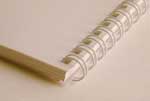 |
Wire-O Binding
A Wire-O binding holds the covers and pages of a document firmly in place by a double-loop wire inserted through holes drilled in their left edges. All of the document’s pages lay flat when opened, can turn easily through 360°, and stay in perfect registration with adjoining pages.
Wire-O bindings come in nine standard colors and loop diameters from 3/16" to 1-1/4". They can handle documents from 1/8" to 1" thick. Often, they are used to bind reference books, reports, proposals, and calendars. They are durable, but do not permit printing on the document spine or the insertion of new pages.
|
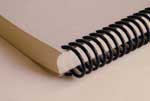 |
Spiral Binding
Spiral bindings cost somewhat more than Wire-O. They may be made of either plastic or wire and allow the printed document to lie flat and to double over, useful characteristics for documents such as technical manuals, notebooks, and calendars.
Spiral binding allows play—hence registration inconsistency—between pages. One cannot add pages to documents once they are spiral bound. Also, rough handling may crush the spirals. Spiral wire coils range from 1/4" to 2" in diameter. They can bind books of up to 24" in length. Plastic coils also may be used as a binding medium.
|
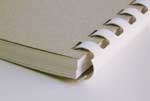 |
Comb Binding
Plastic comb bindings are more vulnerable to damage than spiral bindings. They hold adjoining pages more tightly in register with each other than spiral bindings. They come in several colors and allow screen printing on a document’s spine. They can bind pieces up to 3" thick.
Comb bindings allow pages to lie flat when opened. However, they cannot be doubled back. And inserting them is a hand operation that is quite costly for large numbers of documents.
|
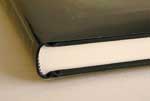 |
Case Binding
In case binding, most often used in book production, a minimum of 60 printed sheets are folded into 16- or 32-page signatures, which are collated and sewn by machine. The sewn edges are coated with glue. Then a strip of gauze adheres to the document’s spine. Finally, the book and its covers are placed in a casing-in machine, which pastes the endpapers and fits the cover.
|
|




